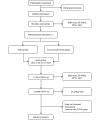Functional Magnetic Resonance Imaging Analysis of the Clinical Effect and Cerebral Mechanism of Tuina in Lumbar Disc Herniation: Protocol for a Randomized Controlled Parallel Group Trial
- PMID: 39348675
- PMCID: PMC11474116
- DOI: 10.2196/63852
Functional Magnetic Resonance Imaging Analysis of the Clinical Effect and Cerebral Mechanism of Tuina in Lumbar Disc Herniation: Protocol for a Randomized Controlled Parallel Group Trial
Abstract
Background: Lumbar disc herniation (LDH) has become a serious public health and socioeconomic problem. Tuina is a Chinese medicine treatment method based on meridian acupuncture theory and modern anatomy. Tuina can relieve pain and muscle tension and improve functional disorders; this massage is performed by pressing, kneading, pushing, pulling, and shaking the skin, muscles, and bones. However, the mechanism of action and the effect of Tuina as an external treatment on the activities of the central nervous system to relieve LDH pain is unclear. Therefore, we performed functional magnetic resonance imaging (fMRI), which is widely used in pain-related research, as it can detect the effects of different types of pain on brain activity.
Objective: Our randomized controlled parallel-group trial aims to compare the effects of Tuina with those of transcutaneous electrical nerve stimulation (TENS) with traction in patients with LDH.
Methods: This trial will be conducted between May 2024 and April 2025 in the Rehabilitation Hospital affiliated to Fujian University of Traditional Chinese Medicine. Seventy-six participants with LDH will be enrolled for this trial and randomly assigned to 2 groups: Tuina intervention group and TENS with traction intervention group. Participants in both groups will receive treatment for 14 days. fMRI will be performed for the main pain measurements by assessing the effect of the intervention on brain activity before and after the end of the intervention. Short-Form McGill Pain Questionnaire, pressure pain thresholds, and the Oswestry disability index will be used to reflect the degree of pain and lumbar dysfunction, and the results will be used as secondary outcome measurements.
Results: The study protocol has been approved by the ethics review committee of The Rehabilitation Hospital affiliated to Fujian University of Traditional Chinese Medicine. This study was registered on May 1, 2024, with the Chinese Clinical Trial Registry. Data collection began on May 2024 and is expected to end on April 2025. Currently, data from this trial are in the collection phase, and no data analysis has been performed. As of July 1, 2024, we have collected data from 21 patients. The results of this trial are expected to be submitted for publication in September 2025.
Conclusions: This clinical trial will compare the effectiveness of Tuina with that of TENS with traction in the treatment of patients with LDH and will show the cerebral mechanism of Tuina in LDH treatment by using fMRI. The results of our trial will be helpful in clarifying the cerebral mechanism of Tuina in the treatment of LDH and provide a solid foundation for Tuina therapy research.
Trial registration: Chinese Clinical Trial Registry ChiCTR2400083784; https://www.chictr.org.cn/showproj.html?proj=225157.
International registered report identifier (irrid): DERR1-10.2196/63852.
Keywords: Tuina; cerebral mechanism; fMRI; functional magnetic resonance imaging; lumbar disc herniation; traction; transcutaneous electrical nerve stimulation.
©Changzheng Jiang, Hongye Huang, Lechun Chen, Jingjing Jiang, Huanzhen Zhang, Jincheng Chen, Shuijin Chen, Zhigang Lin. Originally published in JMIR Research Protocols (https://www.researchprotocols.org), 30.09.2024.
Conflict of interest statement
Conflicts of Interest: None declared.
Figures




Similar articles
-
Cerebral Mechanism of Tuina on the Descending Pain Inhibitory System in Knee Osteoarthritis: Protocol for a Randomized Controlled Trial.JMIR Res Protoc. 2024 Feb 12;13:e52820. doi: 10.2196/52820. JMIR Res Protoc. 2024. PMID: 38238645 Free PMC article.
-
Clinical efficacy of Tuina therapy combined with traditional Chinese exercises in the treatment of symptomatic lumbar disc herniation: a multicentre randomised controlled trial protocol.Front Neurol. 2025 Jan 24;16:1497933. doi: 10.3389/fneur.2025.1497933. eCollection 2025. Front Neurol. 2025. PMID: 39926017 Free PMC article.
-
Efficacy of tuina in patients with chronic neck pain: study protocol for a randomized controlled trial.Trials. 2019 Jan 17;20(1):59. doi: 10.1186/s13063-018-3096-3. Trials. 2019. PMID: 30654844 Free PMC article.
-
Tuina combined with Adjuvant therapy for lumbar disc herniation: A network meta-analysis.Complement Ther Clin Pract. 2022 Nov;49:101627. doi: 10.1016/j.ctcp.2022.101627. Epub 2022 Jul 5. Complement Ther Clin Pract. 2022. PMID: 35849972 Review.
-
Comparisons of the Effectiveness and Safety of Tuina, Acupuncture, Traction, and Chinese Herbs for Lumbar Disc Herniation: A Systematic Review and Network Meta-Analysis.Evid Based Complement Alternat Med. 2019 Mar 20;2019:6821310. doi: 10.1155/2019/6821310. eCollection 2019. Evid Based Complement Alternat Med. 2019. PMID: 31015852 Free PMC article. Review.
References
-
- Yu P, Mao F, Chen J, Ma X, Dai Y, Liu G, Dai F, Liu J. Characteristics and mechanisms of resorption in lumbar disc herniation. Arthritis Res Ther. 2022 Aug 23;24(1):205. doi: 10.1186/s13075-022-02894-8. https://arthritis-research.biomedcentral.com/articles/10.1186/s13075-022... 10.1186/s13075-022-02894-8 - DOI - DOI - PMC - PubMed
-
- Pojskic M, Bisson E, Oertel J, Takami T, Zygourakis C, Costa F. Lumbar disc herniation: Epidemiology, clinical and radiologic diagnosis WFNS spine committee recommendations. World Neurosurg X. 2024 Apr;22:100279. doi: 10.1016/j.wnsx.2024.100279. https://linkinghub.elsevier.com/retrieve/pii/S2590-1397(24)00010-3 S2590-1397(24)00010-3 - DOI - PMC - PubMed
-
- Amin RM, Andrade NS, Neuman BJ. Lumbar disc herniation. Curr Rev Musculoskelet Med. 2017 Dec;10(4):507–516. doi: 10.1007/s12178-017-9441-4. https://europepmc.org/abstract/MED/28980275 10.1007/s12178-017-9441-4 - DOI - PMC - PubMed
-
- Khan AN, Jacobsen HE, Khan J, Filippi CG, Levine M, Lehman RA, Riew KD, Lenke LG, Chahine NO. Inflammatory biomarkers of low back pain and disc degeneration: a review. Ann N Y Acad Sci. 2017 Dec;1410(1):68–84. doi: 10.1111/nyas.13551. https://europepmc.org/abstract/MED/29265416 - DOI - PMC - PubMed
-
- Samuelly-Leichtag G, Eisenberg E, Zohar Y, Andraous M, Eran A, Sviri GE, Keynan O. Mechanism underlying painful radiculopathy in patients with lumbar disc herniation. Eur J Pain. 2022 Jul;26(6):1269–1281. doi: 10.1002/ejp.1947. https://europepmc.org/abstract/MED/35357731 - DOI - PMC - PubMed
Publication types
MeSH terms
LinkOut - more resources
Full Text Sources
Medical
Research Materials
Miscellaneous

